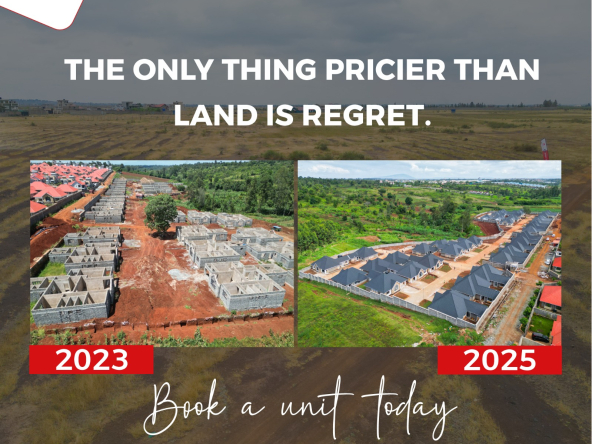Kenya is urbanising fast, but a surprising amount of land inside and around our cities sits idle—bought by investors who wait for roads, metros or new zoning to push prices up. This practice—commonly called land banking—is often presented as a sensible long-term investment. Yet when scaled across peri-urban Nairobi, Mombasa, Kisumu and fast-growing satellite towns, it becomes a structural drag on housing supply, public infrastructure delivery and the affordability of homes. This investigation explains how, why and with what consequences land banking in Kenya matters — and offers practical steps for policy-makers, counties and buyers.
What is Land Banking — and Why it’s Not Just a Private Problem
At its simplest, land banking is buying land and holding it undeveloped until its value rises. In Kenya that behaviour is fuelled by weak planning, patchy enforcement of rates and taxes, and big public projects (expressways, Konza, rail links) that create speculative hotspots. Developers and investors who hold large tracts expect outsized capital gains; meanwhile the market sees less land available for immediate housing development. This raises prices and delays infrastructure connections that depend on contiguous development.
The Scale: Short Data Snapshot (what the numbers say)
Below are the load-bearing national data points that show why land hoarding matters for housing and planning in Kenya.
| Indicator | Figure (most recent) | Source |
|---|---|---|
| Estimated housing deficit (nationwide) | ~2,000,000 units | Habitat for Humanity / country data. |
| Annual housing demand | ~250,000 units per year | Habitat for Humanity / national estimates. |
| Reported annual supply (formal units) | ~50,000 units per year | Habitat for Humanity / national estimates. |
| Nairobi County land rates arrears | ~KShs 50 billion (reported collection shortfall) | Nation reporting on rate defaulters and City Hall action. |
| Share of urban centres with secured development approvals | ~20% (reporting by sector bodies) | Architectural Association of Kenya / urban planning brief. |
| New legal/regulatory framing (Affordable Housing Act) | Affordable Housing Act enacted 19 Mar 2024 (policy push) | Legal analysis / Bowmans. |
| KNBS Real Estate and Housing data availability | Real-estate/housing surveys conducted 2023–24 — detailed price and supply metrics. | KNBS Real Estate & Housing Survey 2023/24 (KNBS). |
These figures show a major mismatch: demand vastly outstrips supply while valuable urban land sits unused—precisely the dynamic that amplifies price inflation and blocks infrastructure economies of scale.
Read Also: Emerging Real Estate Hotspots in Kenya: Where Smart Investors Are Looking in 2025 and Beyond
How Land Banking Raises Prices and Throttles Housing Supply

- Artificial scarcity. When speculators buy and hold multiple adjacent parcels, contiguous land needed for a block of affordable housing becomes fragmented or unavailable, raising land acquisition costs for builders and cutting feasible project sizes. Academic work on peri-urban Nairobi links bypass planning announcements to spikes in speculative buying.
- Delayed infrastructure rollout. Counties and national agencies plan roads, sewer, water and power assuming development will follow. But if landowners leave parcels idle, the unit economics of utility rollout and estate servicing change; agencies and developers delay investment until parcels consolidate, further postponing homes.
- Fiscal leakage and weak incentives. Large arrears in land rates and weak enforcement reduce county revenues that would otherwise pay for site servicing and affordable housing subsidies. Nairobi County’s recent move to crack down on defaulters reveals how much revenue has been unpaid—and how enforcement can alter incentives.
- Speculative corridors. Announcements of major projects (expressways, Konza, rail) create speculation corridors. Investors buy ahead of announcements or immediately after, banking on appreciation and not development—pushing peri-urban land prices beyond the reach of small-scale builders.
Real-World Examples and Consequences
- Satellite towns like Ruiru, Thika and areas along the Eastern Bypass show clustered undeveloped plots purchased in expectation of expressway-linked gains. This shifts demand away from inner-city infill and increases commuting distances and infrastructure costs.
- Developers report that small to medium builders cannot assemble financially viable parcels because landowners hold out for higher per-acre prices, making affordable housing projects unworkable without subsidy or compulsory acquisition. (Supported by KNBS real estate survey trends and industry commentary).
Policy Levers and Practical Fixes (what can change)
These are actionable measures counties, national government and market actors can adopt to reduce the harms of land banking and unlock housing supply.
For national and county governments
- Strengthen land rates and enforcement. Use the National Rating Act and county powers to reduce arrears and create carrying costs for idle land; Nairobi’s recent enforcement drive shows collection potential.
- Introduce a targeted idle-land levy or staged tax relief. A calibrated levy on undeveloped peri-urban parcels (with exemptions for bona fide long-term public projects) creates a holding cost that encourages development or sale. (Many policy papers and land-use frameworks recommend such fiscal disincentives.)
- Operationalise public land banking for social housing. Governments and public agencies can acquire strategic parcels then solicit affordable housing PPPs—turning speculative land into deliverable projects under the Affordable Housing Act.
For developers, investors and communities
- Land assemblies and cooperative purchase models. Small developers pool capital to assemble contiguous parcels, reducing the need to outbid speculators.
- Transparent data and land registries. County-level land-use dashboards and faster title verification reduce asymmetric information that fuels speculation. KNBS real-estate surveys provide the baseline data to design local interventions.
For buyers (practical advice)
- Check county development plans and whether a parcel is part of a speculative corridor (proximity to announced projects does not guarantee servicing).
- Insist on rate clearances and request copies of any improvement notices—counties are increasingly enforcing collections and a backlog can create future legal headaches.
Read Also: Smart Contracts in Real Estate: The End of Long, Paper-Based Agreements?
Table: Quick Policy Impact Comparison
| Policy | Expected short-term effect | Likely medium-term outcome |
|---|---|---|
| Idle-land levy | Faster release of small/medium parcels | Increased available land for housing; moderated price growth |
| Stronger rate enforcement | Higher county collections; political friction | More funds for site servicing; lower carrying costs for municipalities |
| Public land banking for social housing | Requires budget/financing | Direct delivery of affordable units; market stabilisation |
Counterarguments and Real Constraints
- Some land banking supports large infrastructure: occasionally long-term private ownership aligns with public projects (e.g., strategic industrial parks). The aim of policy is not to eliminate private investment but to disincentivise passive hoarding that blocks urban function.
- Implementation capacity at county level varies. Many counties lack GIS, valuation or legal capacity—addressing these gaps is central to any fix. The Architectural Association of Kenya notes that only a minority of urban centres have secured development approvals, pointing to institutional gaps that fuel speculation.
A pragmatic Way Forward
Land banking in Kenya is not merely an investor puzzle; it’s a market failure with social consequences. With a housing deficit measured in the millions and ambitious national targets for affordable units, unchecked land hoarding raises prices and delays infrastructure that benefits everyone. Targeted policy reforms—enforced rates, idle-land levies, land assembly tools and proactive public land-banking for social housing—would convert speculative value into homes, schools and jobs. The alternative is a perpetually deferred housing supply and rising costs for the very Kenyans the housing agenda is meant to help.




